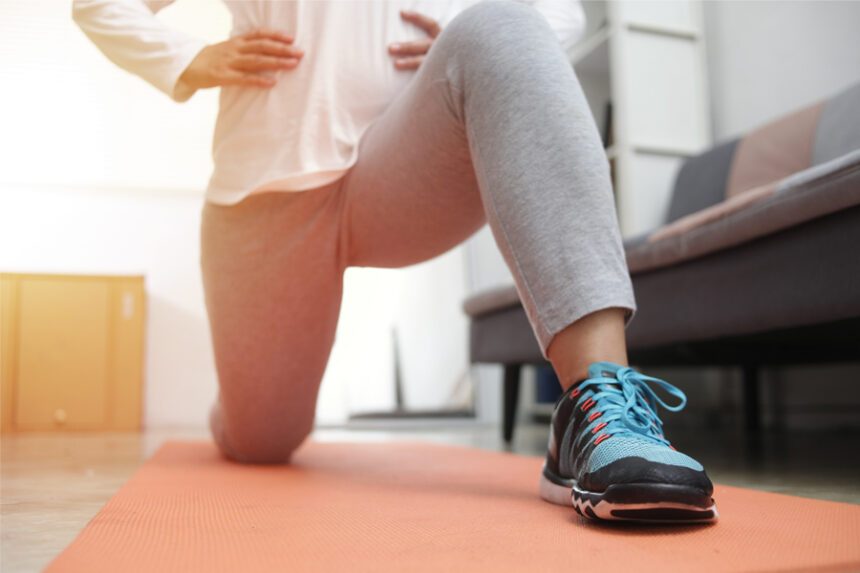We spend a lot of our days sitting down. We go from our desks at school or work to our cars and then to our couch to watch television and play on our phones. Sitting and sedentary behavior have been linked with many health issues, including heart disease, diabetes and certain types of cancer.
Sitting can also cause pain in your body, even if you have an ergonomic chair.
“Adults and children spend an average of eight hours or more sitting,” says UNC Health orthopedic surgeon Chad Parkes, MD. “This may lead to tightness of the hip flexors, which can have many effects on posture, muscle fatigue, low back pain, and difficulty walking or moving.”
We talked to Dr. Parkes and Kathy DeBlasio, UNC Health Wellness Services manager and certified personal trainer, about the role of hip flexors in our body and how we can keep them working well.
The Function of Hip Flexors
The hip flexors are a set of muscles that allow you to walk, climb stairs and bend at the waist. “When you bring your knee toward your chest, you’re using your hip flexors,” DeBlasio says.
These muscles are at the front of the hip and thigh and include the psoas major, iliacus and rectus femoris. The hip flexors connect the spine to the pelvis and upper thighs. “They’re incredibly important for hip and low back mobility as well as posture,” Dr. Parkes says.
When we stand or move, our hip flexors are activated, even if we don’t notice them. But because we spend so much of our day sitting, they can lose their ability to work as well as they should.
Common Hip Flexor Problems
Inactivity leads to weak and tight hip flexors.
“When we sit, our hip flexors shorten and tighten,” DeBlasio says. “Then, when we stand, the shortened muscles pull the pelvis down and forward, which causes low back pain and pain in the hamstrings.”
When your hip flexors are weak or tight, other muscles may overcompensate to help you move, which can lead to pain, an altered gait and an increased risk of injury. Over time, tight hip flexors can reduce the hips’ ability to move through their natural range of motion.
“We want to keep all the muscle groups working at their full capacity,” Dr. Parkes says. “When we can’t achieve that full range of motion in one group of muscles, we can’t use the other muscle groups effectively.”
Also, as with other muscles, the hip flexors can be strained from overuse or injury. Athletes commonly strain their hip flexors by changing directions suddenly while running or by making explosive movements, such as extending the hip muscle to kick a moving ball. Hip flexor strains can cause pain, tightness in the hip and difficulty walking. Stretching and warming up before exercise or athletic activity can help to prevent hip flexor strains.
Strengthening the Hip Flexors
Preventing hip flexor tightness is as simple as standing up.
“Make sure you get up from your seat every hour and move,” DeBlasio says.
There are many postures in yoga that stretch the hip flexors, including bridge, pigeon and lizard poses and low lunges. Because your hips are part of your core, exercises that strengthen the core will also help your hips.
“It’s really important to stretch,” Dr. Parkes says. “Just as we have daily activities related to hygiene, it’s important to implement a stretching protocol, especially if you spend long periods of time sitting throughout the day.”
Stretching can be done every day, DeBlasio says, to include inner and outer thigh stretches as well as hip rotators and hip flexors. Flexion, extension, abduction and adduction make up the full range of motion for the hip joint.
“For hip flexion, hold your leg straight in front of you, or bent at the knee,” she says. “For hip extension, extend your straight leg behind you. For hip abduction, bring your leg to the side. For hip adduction, bring your leg across your midline.”
If you’re feeling pain in your hips, a physical therapist or personal trainer can prescribe more specific exercises. This professional can tell whether you’re experiencing a hip flexor issue based on posture, movement or gait and perform tests of muscle tension.
Because hip flexors are so important to movement, you shouldn’t ignore any pain there.
“See a doctor if you have sharp, intense pain in your hips,” DeBlasio says. “If the pain isn’t sharp or intense but you’ve had it for more than six weeks, see a doctor.”
If you’re experiencing muscle or joint pain, talk to your doctor. Need a doctor? Find one near you.

